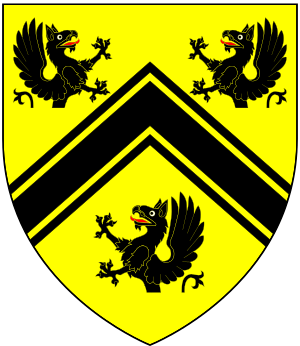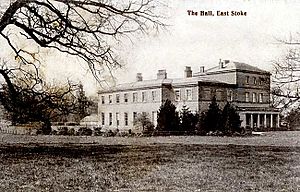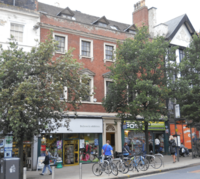Sir George Smith, 1st Baronet facts for kids

Sir George Smith, 1st Baronet (1714–1769) of Smith House (later "Bromley House"), Angel Row, Nottingham and of Stoke Hall in the parish of East Stoke in Nottinghamshire, was a member of the Smith family of bankers, who established Smith's Bank in Nottingham in 1658. He was created a baronet "of East Stoke in the County of Nottingham", a title in the Baronetage of Great Britain, on 31 October 1757.
Origins
He was the eldest son of Abel Smith I (1686–1756) of Nottingham, the 2nd son of Thomas Smith I (1631–1699), the founder of Smith's Bank in Nottingham. His younger brothers included: Abel Smith II (1717–1788) (father of Robert Smith, 1st Baron Carrington and of John Smith (1767–1842) of Blendon Hall, MP, great-grandfather of Vivian Smith, 1st Baron Bicester (1867–1956)) and John Smith (born 1716), ancestor of Julian Pauncefote, 1st Baron Pauncefote (1828-1902).
His mother was Jane Beaumont (1689-1743), a daughter of George Beaumont of Chapelthorpe in Yorkshire.
Marriages & issue
He married twice:
- Firstly to Mary Howe (1726-1761), daughter and sole heiress of Major William Howe (1699-1733) by his wife Elizabeth Pauncefote, one of the two daughters and co-heiresses of William Pauncefote (d.1711) of Carswalls in Newent, and of Preston, near Dymock, both in Gloucestershire. Elizabeth's sister and co-heiress Sarah Pauncefote was the wife of William Bromley (d.1769) of Abberley Hall near Stourport-on-Severn in Worcestershire. His father-in-law Major William Howe was the son of Lieutenant-General Emanuel Scrope Howe (c.1663-1709) (the fourth son of John Grubham Howe (1625–1679) of Langar Hall in Nottinghamshire, the younger son of Sir John Howe, 1st Baronet) by his wife Ruperta, the illegitimate daughter of Prince Rupert of the Rhine, grandson of King James I. By his first wife he had issue, of whom only one survived:

-
- Sir George Pauncefote-Bromley, 2nd Baronet (1753–1808), High Sheriff of Gloucestershire in 1775. In 1778 he assumed by Royal licence the surname and arms of Bromley in lieu of his patronymic and in 1803 he assumed by Royal licence the surname of Pauncefote in addition to that of Bromley, having inherited or purchased the outstanding moieties of his maternal estates of Carswalls and Preston from his mother's childless first-cousin Robert Bromley (d.1803) of Abberley. Robert Bromley (d.1803) thus disposed of his maternal estates to the descendant of his mother's sister, but his paternal estate of Abberley he bequeathed to his illegitimate kinsman Col. Henry Bromley (c.1803-1836), a Member of Parliament for Worcester 1806–7, illegitimate son of a certain William Bromley. In 1778 he married Esther Curzon, who brought with her a large dowry, a daughter of Assheton Curzon, 1st Viscount Curzon (1730-1820) of Hagley Hall in Staffordshire. ..... By his wife he had a son and heir:
- Admiral Sir Robert Howe Bromley, 3rd Baronet (1778–1857)
- Sir George Pauncefote-Bromley, 2nd Baronet (1753–1808), High Sheriff of Gloucestershire in 1775. In 1778 he assumed by Royal licence the surname and arms of Bromley in lieu of his patronymic and in 1803 he assumed by Royal licence the surname of Pauncefote in addition to that of Bromley, having inherited or purchased the outstanding moieties of his maternal estates of Carswalls and Preston from his mother's childless first-cousin Robert Bromley (d.1803) of Abberley. Robert Bromley (d.1803) thus disposed of his maternal estates to the descendant of his mother's sister, but his paternal estate of Abberley he bequeathed to his illegitimate kinsman Col. Henry Bromley (c.1803-1836), a Member of Parliament for Worcester 1806–7, illegitimate son of a certain William Bromley. In 1778 he married Esther Curzon, who brought with her a large dowry, a daughter of Assheton Curzon, 1st Viscount Curzon (1730-1820) of Hagley Hall in Staffordshire. ..... By his wife he had a son and heir:
- Secondly in 1768 he married Catherine Vyse (died 1786), a daughter of William Vyse of Lichfield, Archdeacon of Salop.
Monument at East Stoke
His mural monument survives in St Oswald's Church, East Stoke, displaying the arms of Smith ("Or, a chevron cotised sable between three demi-griffins couped of the last the two in chief respecting each other"), with an inescutcheon of pretence of Howe ("Or, a fess between three wolf's heads couped sable" of four quarters) impaling Vyse ("Argent, a buck's head cabossed sable between the attires a cross of the last"). It is inscribed as follows:
- "Sacred to the memory of Sir George Smith Bart of Nottingham and of Stoke Hall who died Sept 5th 1769 aged 55. And of Mary his first wife daughter and sole heiress of William Howe Esqr who died May 18th 1761 aged 35, by whom he had issue: Howe, born June 26th 1749; May, born May 3d 1751; Jane, born July 27th 1760, who all died in their infancy and lie interr'd in the vault underneath this monument with their father and mother. George (their only surviving child) caused this monument to be erected as a testimony of his affectionate regard for his deceased parents."




